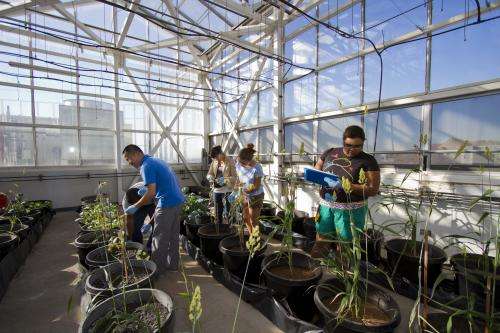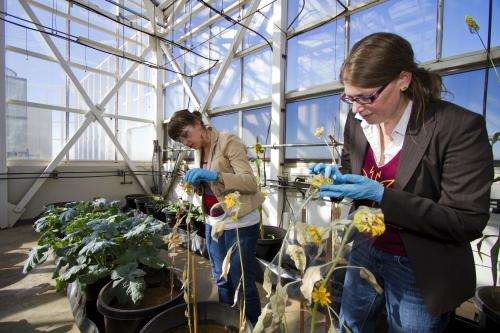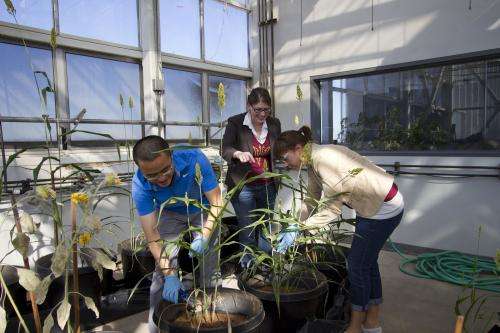Building the framework for the future of biofuels

Biofuels—fuels made from plants—are seen by many as one of the better options for brightening the national energy outlook.
They offer a promising renewable resource as a replacement for nonrenewable fossil fuels, and a way to reduce the amount of greenhouse gas emissions being pumped into the atmosphere as a result of our use of conventional petroleum-derived fuels.
They could help the United States take major steps to reduce the country's dependence on oil from other parts of the world.
For more than five years Amy Landis has led research that is revealing the potential rewards of developing large-scale biofuels production, as well as the potential drawbacks we would face in the effort.
"We are documenting that there would be environmental benefits, but also trade-offs in growing biofuels that would have to be dealt with," said Landis, an associate professor in the School of Sustainable Engineering and the Built Environment, one of the Ira A. Fulton Schools of Engineering at Arizona State University (ASU).
Two National Science Foundation (NSF) grants combined to provide about $650,000 for projects directed by Landis, enabling her to paint a clearer picture of the impacts of developing a major biofuels industry. Both grants were through the NSF's Chemical, Bioengineering, Environmental and Transport Systems Division.
One project looked at the feasibility of growing bioenergy crops on marginal lands where soil nutrients first have to be restored to enable agricultural use. A second project involved forecasting the environmental impacts of next-generation biofuels.
According to Landis, lands damaged by industrial waste or other pollutants could be restored sufficiently to support agriculture for growing bioenergy crops.

Landis' team was able to use other forms of nonhazardous industrial waste materials to neutralize the acidity of soil at polluted sites—particularly abandoned mining lands. The method restored fertility to a level that allowed many of the plants, from which biofuels are derived, to grow.
As a result, biofuels agriculture could become a significant contributor to soil remediation, land reclamation and natural storm water management that fertile, absorbent ground can provide.
A complex system
A downside is that many biofuel crops, like food crops, require fertilizers that cause water degradation, and the water carrying the fertilizers can be transported by runoff into other areas where they can do environmental harm.
To fully understand the ramifications of a big commitment to cultivation of biofuel sources, Landis said she took a holistic approach that examines the entire life cycle of bio-based products.
She looked beyond the benefits of greenhouse gas reductions and energy savings to the challenges of weighing long-term benefits and potential problems.

Landis has been able to quantify some potential future nationwide impacts of growing the various kinds of bioenergy plants—corn grain, soybeans, switchgrasses, canola and algae, for example—to extensively assess economic, social and environmental effects.
That included evaluating the feasibility of bioenergy crops to meet the Energy Independence and Security Act Renewable Fuel Standards, which sets challenging goals for fuel production quantity.
The project involved consideration of the various agricultural and environmental management strategies that would be critical to preventing or mitigating undesirable consequences that could result from growing bioenergy crops to manufacturing biofuels.
The work was also intended to provide a framework for a life-cycle assessment method that can be applied to future evaluations of biofuels cultivation and production, and for gauging the sustainability of various fuel development strategies throughout the United States.
"Our work shows there is no silver-bullet biofuel that provides a perfect sustainability solution," Landis explained. "Developing domestic sustainable fuels is a complex problem and we must consider the wide range of environmental impacts, economic ramifications and social factors.
"In particular for biofuels that rely heavily on fertilizer, our work shows that we should pay particular attention to protecting water quality," she said. "However, it's not all doom and gloom. Our NSF-funded research also developed some creative solutions to utilize abandoned lands and waste materials to produce biofuels."
Provided by National Science Foundation















